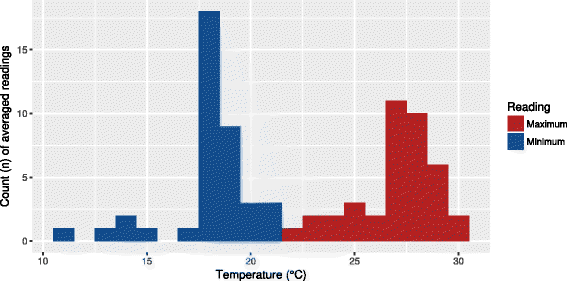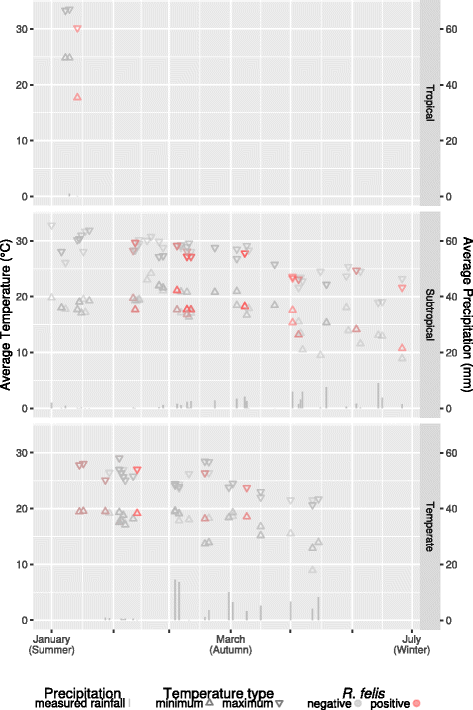The epidemiology of Rickettsia felis infecting fleas of companion animals in eastern Australia
- PMID: 29554953
- PMCID: PMC5859732
- DOI: 10.1186/s13071-018-2737-4
The epidemiology of Rickettsia felis infecting fleas of companion animals in eastern Australia
Abstract
Background: Flea-borne spotted fever (FBSF) caused by Rickettsia felis is an arthropod-borne zoonosis. This study aimed to determine the prevalence, primary species and genotype(s) of R. felis infecting fleas from dogs and cats.
Results: All fleas were identified as Ctenocephalides felis felis. All rickettsial DNA detected in fleas was identified as being 100% homologous to R. felis URRWXCal2, with positivity within tropical, subtropical and temperate regions noted at 6.7%, 13.2% and 15.5%, respectively. Toy/small breed dogs were found to be at a lower odds of harboring R. felis-positive fleas compared with large breed dogs on univariate analysis, while DMH and pedigree breed cats were at a lower odds compared to DSH cats. Cooler minimum temperature ranges of between 15 to 20 °C and between 8 to 15 °C increased the odds of R. felis positivity in fleas, as did a constrained maximum temperature range of between 27 to 30 °C on multivariable analysis.
Conclusions: Environmental temperature may play a part in influencing R. felis prevalence and infectivity within its flea host. Regional climatic differences need to be considered when approaching public health risk mitigation strategies for FBSF.
Keywords: Australia; Ctenocephalides felis; Rickettsia; Rickettsia felis; Temperature.
Conflict of interest statement
Ethical approval and consent to participate
Not applicable.
Consent for publication
Not applicable.
Competing interests
The authors declare that they have no competing interests.
Publisher’s Note
Springer Nature remains neutral with regard to jurisdictional claims in published maps and institutional affiliations.
Figures



Similar articles
-
Rickettsia felis in Ctenocephalides felis felis from five geographic regions of Brazil.Am J Trop Med Hyg. 2014 Jul;91(1):96-100. doi: 10.4269/ajtmh.13-0699. Epub 2014 Apr 28. Am J Trop Med Hyg. 2014. PMID: 24778194 Free PMC article.
-
Detection of Rickettsia Species in Fleas Collected from Cats in Regions Endemic and Nonendemic for Flea-Borne Rickettsioses in California.Vector Borne Zoonotic Dis. 2016 Mar;16(3):151-6. doi: 10.1089/vbz.2015.1869. Epub 2016 Jan 29. Vector Borne Zoonotic Dis. 2016. PMID: 26824189
-
Rickettsial Infections among Cats and Cat Fleas in Riverside County, California.Am J Trop Med Hyg. 2018 Aug;99(2):291-296. doi: 10.4269/ajtmh.17-0706. Epub 2018 May 31. Am J Trop Med Hyg. 2018. PMID: 29869607 Free PMC article.
-
Prevalence of Rickettsia felis DNA in the blood of cats and their fleas in the United States.J Feline Med Surg. 2007 Jun;9(3):258-62. doi: 10.1016/j.jfms.2006.12.005. Epub 2007 Feb 2. J Feline Med Surg. 2007. PMID: 17276123 Free PMC article. Review.
-
Rickettsia felis is an emerging human pathogen associated with cat fleas: A review of findings in Taiwan.J Microbiol Immunol Infect. 2023 Feb;56(1):10-19. doi: 10.1016/j.jmii.2022.12.006. Epub 2022 Dec 17. J Microbiol Immunol Infect. 2023. PMID: 36585292 Review.
Cited by
-
Cat fleas (Ctenocephalides felis clade 'Sydney') are dominant fleas on dogs and cats in New South Wales, Australia: Presence of flea-borne Rickettsia felis, Bartonella spp. but absence of Coxiella burnetii DNA.Curr Res Parasitol Vector Borne Dis. 2021 Jul 30;1:100045. doi: 10.1016/j.crpvbd.2021.100045. eCollection 2021. Curr Res Parasitol Vector Borne Dis. 2021. PMID: 35284882 Free PMC article.
-
Vector biology of the cat flea Ctenocephalides felis.Trends Parasitol. 2024 Apr;40(4):324-337. doi: 10.1016/j.pt.2024.02.006. Epub 2024 Mar 7. Trends Parasitol. 2024. PMID: 38458883 Free PMC article. Review.
-
Prediction of potential drug targets and key inhibitors (ZINC67974679, ZINC67982856, and ZINC05668040) against Rickettsia felis using integrated computational approaches.Front Vet Sci. 2025 Jan 16;11:1507496. doi: 10.3389/fvets.2024.1507496. eCollection 2024. Front Vet Sci. 2025. PMID: 39885844 Free PMC article.
-
Role of vector-borne pathogens in the development of fever in cats: 1. Flea-associated diseases.J Feline Med Surg. 2020 Jan;22(1):31-39. doi: 10.1177/1098612X19895941. J Feline Med Surg. 2020. PMID: 31916873 Free PMC article. Review.
-
Cost-Effectiveness of Treatment for Canine Parasites in Remote Indigenous Communities.Ecohealth. 2025 Jun;22(2):296-308. doi: 10.1007/s10393-025-01718-w. Epub 2025 May 21. Ecohealth. 2025. PMID: 40399556 Free PMC article.
References
-
- Hii S-F, Lawrence AL, Cuttell L, Tynas R, Abd Rani PAM, Šlapeta J, et al. Evidence for a specific host-endosymbiont relationship between ‘Rickettsia sp. Genotype RF2125’ and Ctenocephalides felis orientis infesting dogs in India. Parasit Vectors. 2015;8:169. doi: 10.1186/s13071-015-0781-x. - DOI - PMC - PubMed
-
- Šlapeta Š, Šlapeta J. Molecular identity of cat fleas (Ctenocephalides felis) from cats in Georgia, USA carrying Bartonella clarridgeiae, Bartonella henselae and Rickettsia sp. RF2125. Vet Parasitol. 2016;3–4:36–40. - PubMed
Publication types
MeSH terms
Substances
Grants and funding
LinkOut - more resources
Full Text Sources
Other Literature Sources
Miscellaneous

